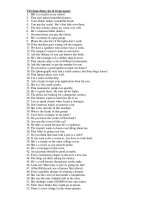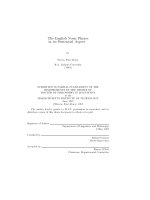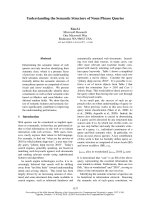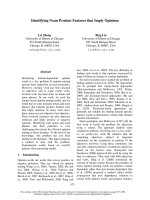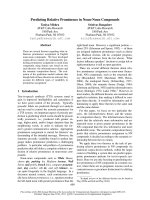noun 4
Bạn đang xem bản rút gọn của tài liệu. Xem và tải ngay bản đầy đủ của tài liệu tại đây (223.71 KB, 16 trang )
<span class='text_page_counter'>(1)</span><div class='page_container' data-page=1>
<b>Problems with Nouns</b>
<b>Problems with Nouns</b>
<b>Singular or Plural????</b>
<b>Singular or Plural????</b>
Woman?
</div>
<span class='text_page_counter'>(2)</span><div class='page_container' data-page=2>
<b>Introduction</b>
<b>Introduction</b>
<b>Problems with Nouns</b>
Look at the sentences below. What’s wrong? Move your
mouse over each sentence to see the answer.
<b>1. I have three bedroom in my house.</b>
<b>2. There are many milks in the refrigerator.</b>
<b>3. Those chair are in the wrong room.</b>
<b>4. There are five reds cars.</b>
<b>5. Some of the class are at night.</b>
<b>6. Your childs are beautiful.</b>
“Bedrooms” should be
plural because the
sentence says there are
three.
“Bedrooms” should be
plural because the
sentence says there are
three. The word “milks” is
</div>
<span class='text_page_counter'>(3)</span><div class='page_container' data-page=3>
<b>Guideline #1</b>
<b>Guideline #1</b>
<b>Count and Non-Count Nouns</b>
In English, we have countable and non-countable nouns.
Some examples of countable and non-countable nouns are
below.
<b>Countable Nouns</b>
<b>Non-Countable Nouns</b>
</div>
<span class='text_page_counter'>(4)</span><div class='page_container' data-page=4>
<b>Guideline #2</b>
<b>Guideline #2</b>
<b>Countable Nouns</b>
Countable nouns can have singular and plural forms and
can be counted numerically. Most countable nouns can be
made plural by adding
<i>–s</i>
or
<i>–es</i>
.
<b>book</b>
<b>books</b>
<b>3 books</b>
</div>
<span class='text_page_counter'>(5)</span><div class='page_container' data-page=5>
<b>Guideline #3</b>
<b>Guideline #3</b>
<b>Non-Countable Nouns</b>
Non-countable nouns have only one form and can’t be
counted numerically. Look at the examples below.
<b>monies</b>
<b>money</b>
<b>one money</b>
<b>money</b>
<b>healths</b>
<b>health</b>
</div>
<span class='text_page_counter'>(6)</span><div class='page_container' data-page=6>
<b>Guideline #4</b>
<b>Guideline #4</b>
<b>Non-Countable Nouns</b>
Non-countable nouns cannot take the plural
<i>–s </i>
or
<i>–es</i>
or
an article
<i>(a, an).</i>
<b>a furniture</b>
<b>furniture</b>
<b>furnitures</b>
<b>furniture</b>
<b>a news</b>
<b>news</b>
</div>
<span class='text_page_counter'>(7)</span><div class='page_container' data-page=7>
<b>Guideline #5</b>
<b>Guideline #5</b>
<b>Irregular Plural Nouns</b>
Some nouns have an irregular plural form. Look at
the examples below.
<b>child</b>
<b>childs</b>
<b>children</b>
<b>woman</b>
<b>womans</b>
<b>women</b>
</div>
<span class='text_page_counter'>(8)</span><div class='page_container' data-page=8>
<b>Guideline #6</b>
<b>Guideline #6</b>
<b>Noun Quantifiers</b>
Words like, a few, a little, much, any, some, and many
are used differently depending on whether the noun in the
sentence is count or non-count.
<b>a few</b>
<b>count nouns </b>
<b>a few</b>
<b> bananas</b>
<b>a little</b>
</div>
<span class='text_page_counter'>(9)</span><div class='page_container' data-page=9>
<b>(Continued)</b>
<b>(Continued)</b>
<b>Noun Quantifiers</b>
<b>many</b>
<b>count nouns </b>
<b>many</b>
<b> chairs</b>
<b>much</b>
<b>non-count nouns </b>
<b>much</b>
<b> furniture</b>
<b>some</b>
</div>
<span class='text_page_counter'>(10)</span><div class='page_container' data-page=10>
<b>(Continued)</b>
<b>(Continued)</b>
<b>Noun Quantifiers</b>
<i><b>Any is used in negative sentences with count and </b></i>
non-count nouns. Notice the difference in plural and
singular verbs.
<b>any</b>
<b>count nouns </b>
<b>There aren’t </b>
<b>any</b>
<b> chairs.</b>
<b>any</b>
</div>
<span class='text_page_counter'>(11)</span><div class='page_container' data-page=11>
<b>Guideline #7</b>
<b>Guideline #7</b>
<b>Agreement with Demonstrative Adjectives</b>
Remember to make demonstrative adjectives
<i><b>(this, that, </b></i>
<i><b>these, those)</b></i>
agree with the nouns they modify.
<b>singular </b>
<b>This/That</b>
<b>these room</b>
<b>plural </b>
<b>These/Those</b>
<b>these rooms</b>
</div>
<span class='text_page_counter'>(12)</span><div class='page_container' data-page=12>
<b>Guideline #8</b>
<b>Guideline #8</b>
<b>Nouns and “of phrases”</b>
A countable noun is always plural after an
<i><b>“of phrase”</b></i>
that
shows quantity. A non-count noun is always singular after an
“of phrase.”
<b>“of phrases”</b>
<b>Some of the chairs are broken.</b>
<b>Some of the furniture is broken.</b>
<b>plural</b>
</div>
<span class='text_page_counter'>(13)</span><div class='page_container' data-page=13>
<b>Guideline #9</b>
<b>Guideline #9</b>
<b>Adjectives</b>
Adjectives are never plural.
<b>Those are beautifuls houses.</b>
<b>beautiful</b>
<b>That is an olds book.</b>
<b>old</b>
adjective
</div>
<span class='text_page_counter'>(14)</span><div class='page_container' data-page=14>
<b>Practice Exercises</b>
<b>Practice Exercises</b>
Click on the links below to look at additional grammar notes
and do some practice exercises with count and non-count
nouns.
</div>
<span class='text_page_counter'>(15)</span><div class='page_container' data-page=15>
<b>Practice Exercises</b>
<b>Practice Exercises</b>
Now you are ready to practice what you’ve learned. Click the
link below to return to Unit D. Print and complete the
</div>
<span class='text_page_counter'>(16)</span><div class='page_container' data-page=16>
<b>Editing Checklist</b>
<b>Editing Checklist</b>
<b>After you have checked your essay for singular/plural noun </b>
<b>problems, read your essay draft aloud to your tutor. As you </b>
<b>read it,listen to make sure there are no errors in </b>
<b>singular/plural nouns.</b>
</div>
<!--links-->
